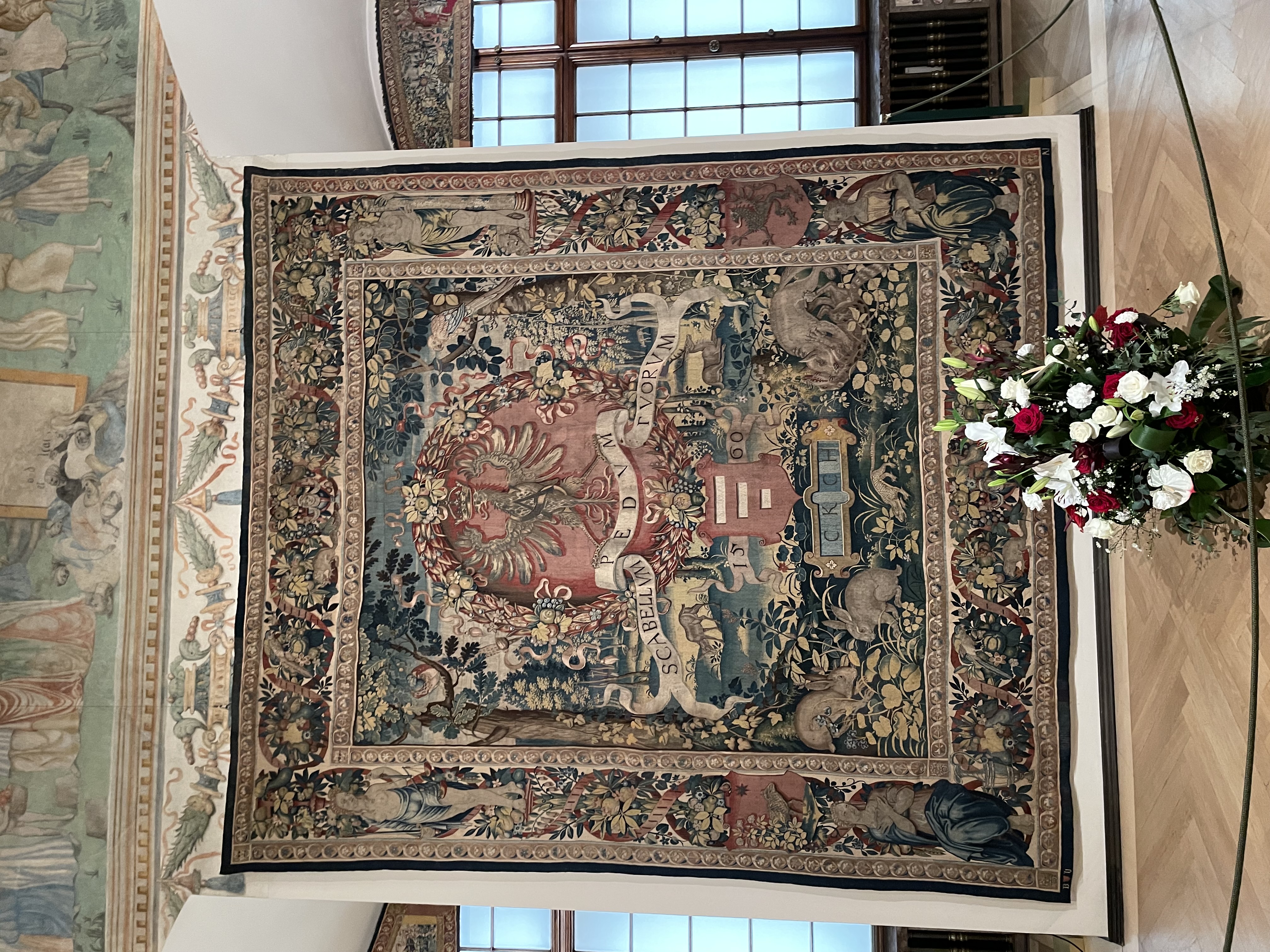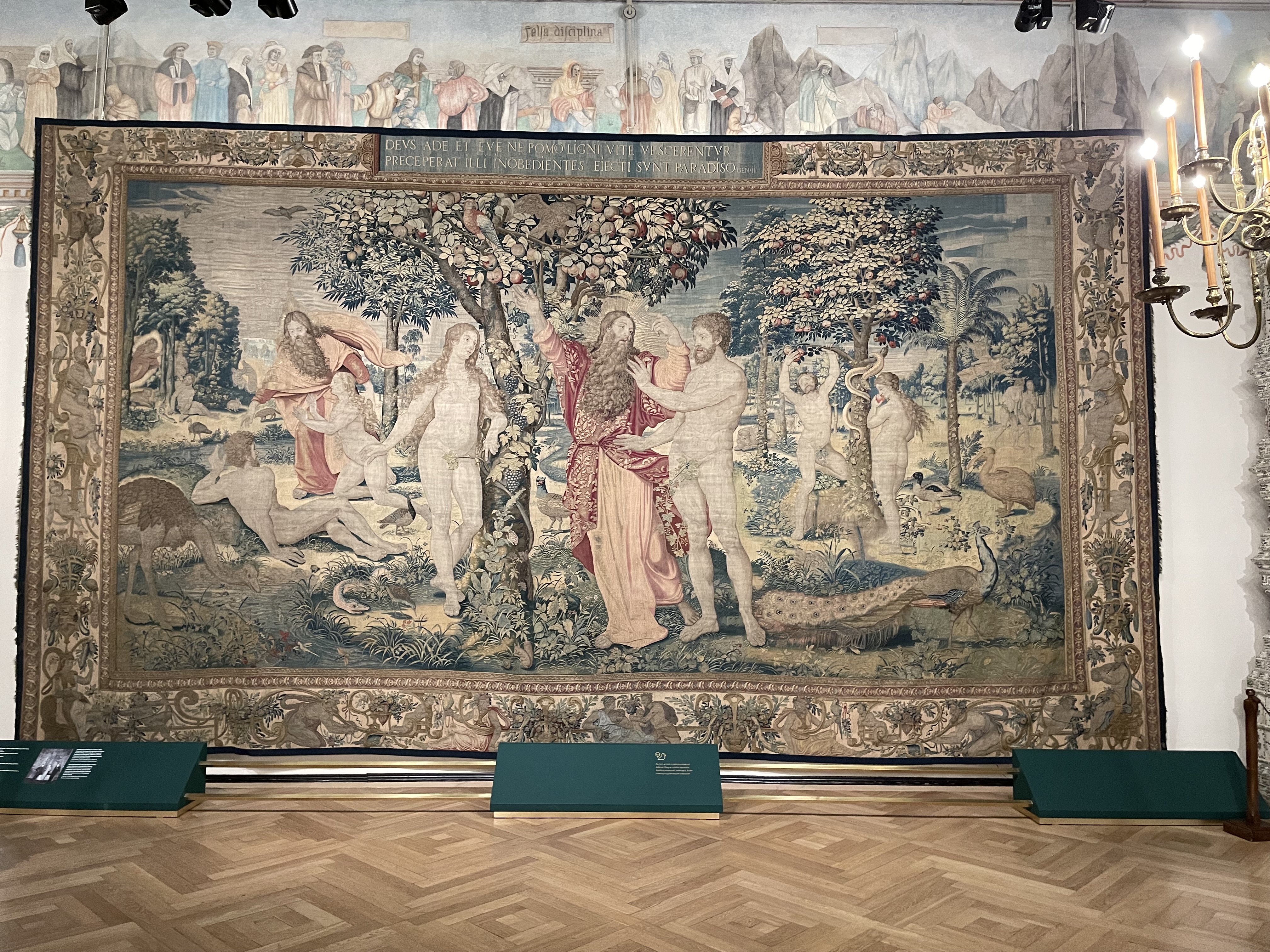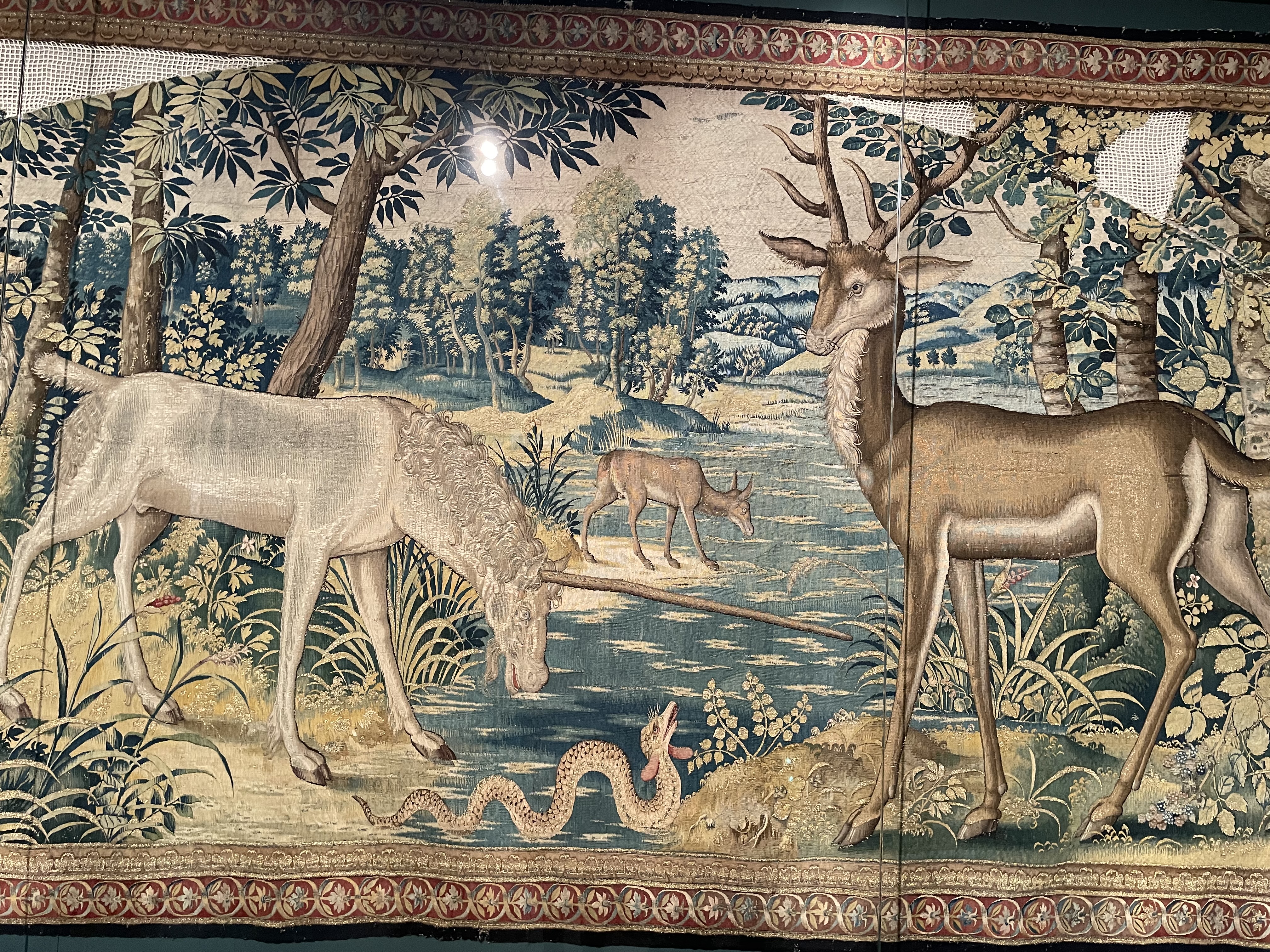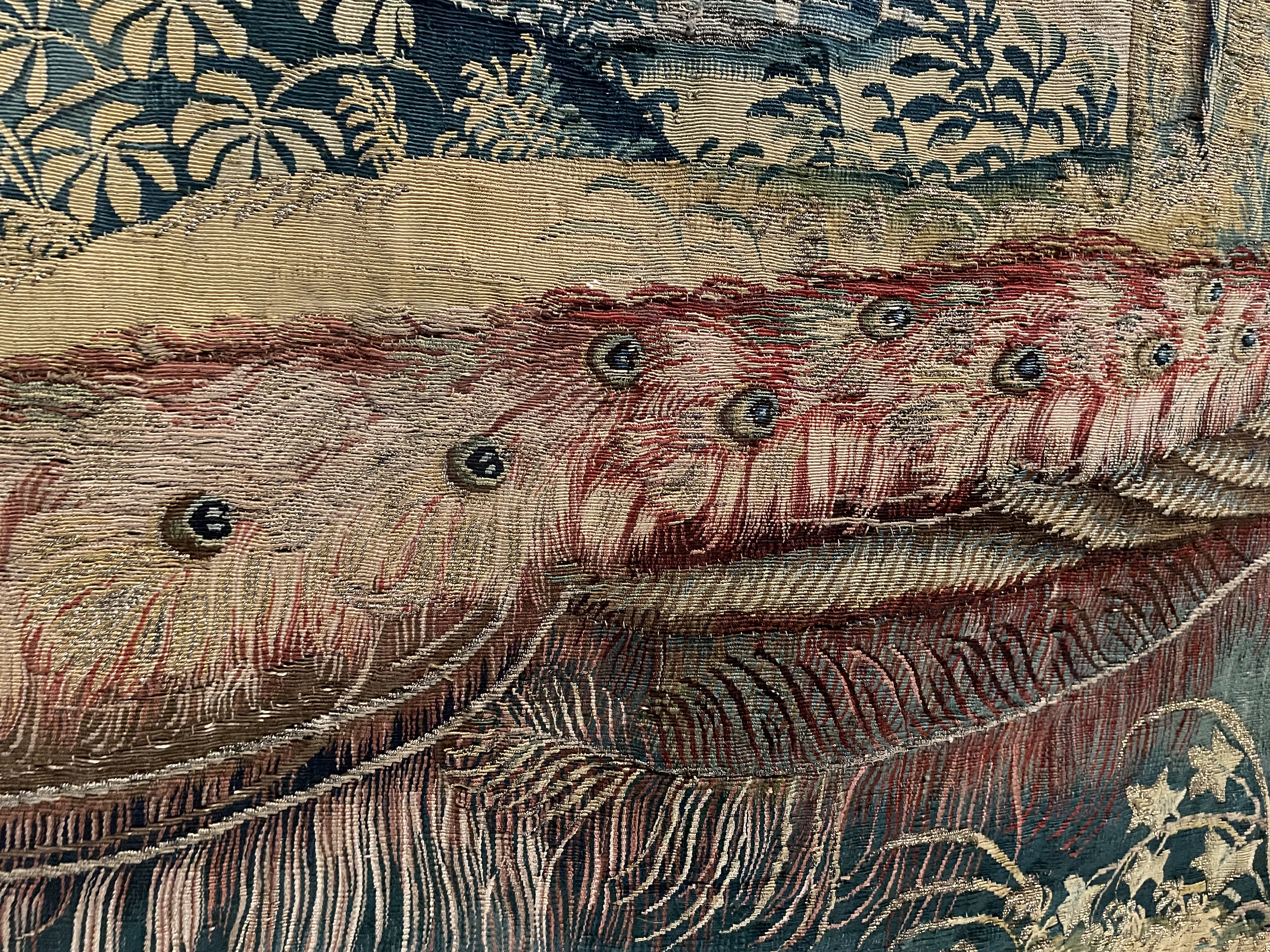Królewskie arrasy/ Royal tapestries
Arrasy wraz ze Szczerbcem przejęły swoisty symbol państwowości polskiej. Zamówione i zakupione w Brukseli, w XVI (kolekcję tę datuję się na ok. 1550/60). wieku przez króla Zygmunta II Augusta. Bruksela była ówcześnie ośrodkiem tkactwa tapisier. Obecnie liczy ona 138 sztuk z około 200. Tapisiery te są jedyną pozostałością Wawelu z okresu renesansu.
Wykonane wg projektów artystów niderlandzkich, tapisiery tkane są nićmi najwyższej klasy: wełną, jedwabiem, nićmi srebrnymi i złotymi, brokatem.
Kolekcja sygnowana jest znakami warsztatów m.in. Pietera van Aelsta, Jana de Kempeneeera, Willema de Kempeneera, Jana van Tieghema.
Arrases together with Szczerbiec took over the specific symbol of Polish statehood. Ordered and purchased in Brussels, in the 16th century (the collection dates to circa 1550/60) by King Zygmunt II August. Brussels was at that time a centre of thread weaving. Currently, there are 138 of them out of nearly 200. These tapestries are the only remnants of Wawel from the Renaissance period.
Design by the Nederland artists, tapestries are woven with the highest class threads: wool, silk, silver and gold threads, brocade.
The collection is signed with the marks of workshops of, among others, Pieter van Aelst, Jan de Kempeneeer, Willem de Kempeneer, Jan van Tieghem.
W królewskiej kolekcji wyróżnia się trzy serie arrasów - arrasy biblijne, werdiury (przedstawienia flory i fauny) oraz arrasy herbowe i monogramy (do nich zaliczają się także zaplecki krzeseł, oponki do ozdoby wnęk okiennych i okrycia ław).
Three series of tapestries can be distinguished in the royal collection - biblical tapestries, verdigris (depictions of flora and fauna) and coats of arms and monograms (which also include chair backs, decoration for window niches and bench covers).



Przedstawienie jelenia i jednorożca, który zanurza swój róg w wodzie, oczyszczając ją. Obok jest symboliczny wąż.
The representation of the stag and the unicorn - the unicorn soaking its horn in the stream cleanses the water near a symbolic snake.
Obecnie liczba werdiur wynosi 44 (z 56).
Przedstawienia zwierząt na tle krajobrazu. Arrasy te dały początek manieryzmowi w malarstwie. W renesansie świat natury zajmował bardzo ważne miejsce.
Tapisiery przedstawiają ówcześnie znane i badane zwierzęta. Dzięki pracy animalistów, czy twórczemu dorobkowi Albrechta Durera, zwierzęta oddane są z wielką dbałością o szczegół, a także ich anatomię. W kolekcji możemy również dojrzeć mitologiczne postaci i stworzenia, które z taką samą pieczołowitością i charakterem odnajdujemy na arrasach.
Zwierzęta mają także charakter symboliczny, bowiem na tapiserii z żurawiem widzimy starcie szlachetnego ptaka z wężem, dla żyjących w epoce renesansu miało to jednoznaczny charakter.
Dosłowny charakter ma także ilustracja lwa pożerającego małpę - ówcześnie wierzono, że tylko spożycie małpiego mięsa może uleczyć chorego lwa.
The present verdure number is 44 (out of 56).
Images of animals against a landscape background. These arrases gave rise to Mannerism in painting. In the Renaissance, the natural world occupied a very important place.
Tapestries represent animals that were known and studied at the time. Thanks to the work of fauna researchers or the creative output of Albrecht Durer, animals are rendered with great attention verdure, as well as their anatomy. In the collection, there are also shown mythological figures and creatures, which are found on the tapestries with the same care and character.
Animals also have a symbolic character, on the tapestry with a crane it clashes between a noble bird and a snake, for people living in the Renaissance period this was unambiguous.
The illustration of a lion devouring a monkey also has a literal character - at that time it was believed that only eating monkey meat could cure a sick lion.


Projekty tkanin figuralnych tworzył Michiel I Coxcie z Malines zwany „Rafaelem flamandzkim”, tworzący też w Rzymie. Choć nie ma dokumentów, które wskazywałyby na potwierdzenie jego nazwiska jako autora kartonów do tapestrii, atrybucja wynika z analizy stylistycznej i nie budzi wątpliwości znawców. Warto zwrócić uwagę na wyraźne inspiracje sztuką włoską początku XVI wieku, które artysta poznał podczas swojej nauki w Rzymie.
Analiza porównawcza kompozycji i układów przybliża freski z Kaplicy Sykstyńskiej i papieskich komnat.
*Figural textile designs were created by Michiel I Coxcie of Malines, known as the 'Flemish Raphael', who also worked in Rome. Although there are no documents to confirm his name as the author of tapestry projects, the attribution is based on stylistic analysis and does not raise doubts among the experts. It is also worth noting the clear inspiration of early 16th-century Italian art, which the artist became acquainted with during his study in Rome.
The compositions and arrangements are taken from the frescoes of the Sistine Chapel and the papal chambers.
Historia w skrócie:
Królewskie arrasy nie miały łatwego „życia”. Król, w obawie przed zniszczeniem i rozdrobnieniem kolekcji, podarował ją swoim trzem siostrom, a po śmierci ostatniej z nich miały one przejść na własność Rzeczypospolitej.
Anna Jagiellonka zrzekła się własności do nich i przekazała je do państwowego skarbca. Pomimo swojej użytkowości kolejni władcy traktowali je jako własne.
W czasie potopu szwedzkiego udało się ukryć arrasy, jednak decyzją króla Jana Kazimierza trafiły one jako zastaw do patrycjusza w Gdańsku. Wykupiono je w 1724r. W 1795 roku w wyniku represji związanych z Powstaniem Kościuszkowskim, decyzją carycy Katarzyny II, arrasy trafiły do Petersburga.
Dopiero w 1921 roku, na mocy traktatu ryskiego kończącego wojną polsko- bolszewicką, arrasy mogły powrócić do kraju. Dzięki opisom naocznego świadka zaślubin króla, Stanisława Orzechowskiego, ówczesnym historykom i muzealnikom w II RP udało się rozróżnić dzieła.
Niestety, kilkanaście lat później, 3 września 1939 roku w obawie przed zagrabieniem przez hitlerowców najcenniejszych zbiorów z kolekcji zamku Wawel, dzieła musiały znów opuścić kraj i tak przez Rumunię, Węgry, Francję, Wielką Brytanię, trafiły do Kanady, gdzie przeczekały kolejny reżim w Polsce i szczęśliwie wróciły w 1961 roku. Kolejny arras odnaleziony w zbiorach Kremla został zwrócony w 1977 roku i jest eksponowany na Zamku Królewskim w Warszawie, inna tapiseria trafiła na międzynarodową aukcję sztuki, a następnie do Rijksmuseum w Amsterdamie. Mimo usilnych badań i precyzyjnej pracy losów wielu brakujących tkanin nadal nie znamy, dlatego tak ważna była ochrona zachowanej kolekcji w czasie II wojny światowej.
Historical espresso:
The royal tapestries did not run an easy "life". The king, fearing the destruction and fragmentation of the collection, had given them to his three sisters, and after the death of the last of them, they were to become the property of the Republic of Poland. Anna Jagiellonka relinquished ownership of the artefacts and transferred them to the state treasury. Despite their utility, subsequent rulers treated them as their own. During the Swedish Deluge, the arrases managed to be hidden. According to King Jan Kazimierz' decision, they were pledged to a patrician in Gdańsk. In 1724 tapestries were rebought. In 1795, as a result of repressions connected with the Kościuszko Uprising, by the decision of Tsarina Catherine II, the tapestries were sent to St. Petersburg.
Finally, in 1921, under the Riga Treaty ending the Polish-Soviet War, the tapestries could return to Poland. Thanks to the descriptions made by an eye-witness of the King's nuptials, Stanisław Orzechowski, historians and museum workers of the Second Republic of Poland, could manage to identify the artefacts. Unfortunately, there comes 1939 and the II World War. On September 3rd, 1939, the arrases and the rest of the most valuable castle's collection had to leave the country again, in fear of being robbed by the Nazis. Transported across Romania, Hungary, France, Great Britain, they found their way to Canada, where they survived the next Polish regime and luckily returned in 1961. Another tapestry found in the Kremlin collection was returned in 1977 and is exhibited at the Royal Castle in Warsaw, whereas a different one went to an international art auction and then to the Rijksmuseum in Amsterdam. Despite strenuous research and precise work, the fate of many of the missing fabrics is still unknown, which is why it was so important to protect the preserved collection during World War II.

Piękne, pięknie też by ten post nadawał się do społeczność Sarmacja, gorąco zachęcam do przyszłych publikacji tamże i ślicznie dziękuję za ten kawałek historii!
@tipu curate 5
Upvoted 👌 (Mana: 0/100) Liquid rewards.
Dzięki dzięki ☺️
https://twitter.com/HivePolish/status/1453084397616435211
The rewards earned on this comment will go directly to the person sharing the post on Twitter as long as they are registered with @poshtoken. Sign up at https://hiveposh.com.
Cudowne ❤️